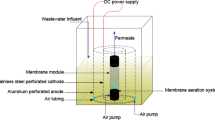Abstract
Three different combinations of treatment techniques, i.e. electrocoagulation combined with microfiltration (EMR), membrane bioreactor (MBR) and electrocoagulation integrated with membrane bioreactor (hybrid MBR, (HMBR)), were analysed and compared for the treatment of tannery wastewater operated for 7 days under the constant trans-membrane pressure of 5 kPa. HMBR was found to be most suitable in performance as well as fouling reduction, with 94 % of chemical oxygen demand (COD) removal, 100 % chromium removal and 8 % improvement in percentage reduction in permeate flux compared to MBR with only 90 % COD removal and 67 % chromium removal. The effect of mixed liquor suspended solids on fouling was also investigated and was found to be insignificant. EMR was capable of elevating the flux but was not as efficient as HMBR and MBR in COD removal. Fouling reduction by HMBR was further confirmed by SEM-EDX and particle size analysis.








Similar content being viewed by others
References
Al-Malack MH (2007) Performance of an immersed membrane bioreactor IMBR. Desalination 214:112–127
Al-Shawabkeh AN, Shen Y, Maillacheruvu KY (2004) Effect of DC electrical fields on COD in aerobic mixed sludge processes. Environ Eng Sci 21:321–329
Apaydin O, Kurt U, Gonullu MT (2009) An investigation on the treatment of tannery wastewater by electrocoagulation. Glob Nest J 11(4):546–555
APHA (1998) Standard methods for the examination of water and wastewater, 20th ed. American Public Health Association, American Water Works Association, Water Pollution Control Federation, Washington, D.C.
Artiga P, Ficara E, Malpei F, Garrido JM, Mende R (2005) Treatment of two industrial waste waters in a submerged membrane bioreactor. Desalination 179:161–169
Chang IS, Kim SN (2005) Wastewater treatment using membrane filtration—effect of biosolids concentration on cake resistance. Process Biochem 40:1307–1314
Chang IS, Lee CH (1998) Membrane filtration characteristics in membrane-coupled activated sludge system—the effect of physiological states of activated sludge on membrane fouling. Desalination 120:221–233
Chen JP, Yang CZ, Zhou JH, Wang XY (2007) Study of the influence of the electric field on membrane flux of a new type of membrane bioreactor. Chem Eng J 128:177–180
Chung Y, Choi H, Lee S, Cho JB (2004) Treatment of tannery wastewater with high nitrogen content using anoxic/oxic membrane bio-reactor (MBR). J Environ Sci Health A 39(7):1881–1890
Defrance L, Jaffrin MY, Gupta B, Paullier P, Geaugey V (2000) Contribution of various constituents of activated sludge to a membrane bioreactor fouling. Bioresour Technol 73:105–112
Golder AK, Samanta AN, Ray S (2007) Removal of trivalent chromium by electrocoagulation. Sep Purif Technol 53:33–41
Govindasamy P, Madhavan SD, Revathi S, Shanmugam P (2006) Performance evaluation of common effluent treatment plant for tanneries at Pallavaram CETP. J Environ Sci Eng 48:213–220
Holt P, Barton G, Mitchell C (1999) Electrocoagulation as a wastewater treatment. The Third Annual Australian Environmental Engineering Research Event. 23–26 November Castlemaine, Victoria
Hong SP, Bae TH, Tak TM, Hong S, Randall A (2002) Fouling control in activated sludge submerged hollow fiber membrane bioreactors. Desalination 143:219–228
Judd S (2005) Fouling control in submerged membrane bioreactors. Water Sci Technol 51:27–34
Keerthi SV, Mahalakshmi M, Balasubramanian N (2013) Development of hybrid membrane bioreactor for tannery effluent treatment. Desalination 309:231–236
Konstantinos D, Achilleas C, Evgenia V (2011) Removal of nickel, copper, zinc and chromium from synthetic and industrial wastewater by electrocoagulation. Int J Environ Sci 1(5):248–253
Le-Clech P, Jefferson B, Judd SJ (2003) Impact of aeration, solids concentration and membrane characteristics on the hydraulic performance of a membrane bioreactor. J Membr Sci 218:117–129
Lee J, Ahn W, Lee C (2001) Comparison of the filtration characteristics between attached and suspended growth microorganisms in submerged membrane bioreactor. Water Res 35:2435–2445
Lee W, Kang S, Shin H (2003) Sludge characteristics and their contribution to microfiltration in submerged membrane bioreactors. J Membr Sci 216:217–227
Liu L, Liu J, Gao B, Yang F (2012) Minute electric field reduced membrane fouling and improved performance of membrane bioreactor. Sep Purif Technol 86:106–112
Melhem KB, Elektorowicz M (2010) Development of a novel submerged membrane electrobioreactor (SMEBR): performance for fouling reduction. Environ Sci Technol 44:3298–3304
Melhem KB, Elektorowicz M (2011) Performance of the submerged membrane electro-bioreactor (SMEBR) with iron electrodes for wastewater treatment and fouling reduction. J Membr Sci 379:434–439
Meng F, Zhang H, Yang F, Zhang S, Li Y, Zhang X (2006) Identification of activated sludge properties affecting membrane fouling in submerged membrane bioreactors. Sep Purif Technol 51:95–103
Munz G, Gualtiero M, Salvadori L, Claudia B, Claudio L (2008) Process efficiency and microbial monitoring in MBR (membrane bioreactor) and CASP (conventional activated sludge process) treatment of tannery wastewater. Bioresour Technol 99:8559–8564
Ramesh Babu R, Bhadrinarayana NS, Meera KM, Begum S, Anantharaman (2007) Treatment of tannery waste water by electro-coagulation. J Univ Chem Technol Metall 42(2):201–206
Solomon PA, Ahmed Basha C, Velan M, Balasubramanian N, Marimuthu P (2009) Augmentation of biodegradability of pulp and paper industry wastewater by electrochemical pre-treatment and optimization by RSM. Sep Purif Technol 69:109–117
Wei FJ, Bing SY, Zheng Z, Zhang JB, Shu LI, Yuan-Chun T (2007) Treatment of tannery wastewater by electrocoagulation. J Environ Sci 19:1409–1415
Yamato N, Kimura K, Miyoshi T, Watanabe Y (2006) Difference in membrane fouling in membrane bioreactors (MBRs) caused by membrane polymer materials. J Membr Sci 280:911–919
Zaroual Z, Azzi M, Saib N, Chainet E (2006) Contribution to the study of electro-coagulation mechanism in basic textile effluent. J Hazard Mater 131:73–78
Zuoa W, Zhanga G, Meng Q, Zhang H (2008) Characteristics and application of multiple membrane process in plating wastewater reutilization. Desalination 222:187–196
Acknowledgments
The first author acknowledges the financial support given by the Department of Science and Technology, India, under the women scientist scheme.
Author information
Authors and Affiliations
Corresponding author
Additional information
Responsible editor: Bingcai Pan
Rights and permissions
About this article
Cite this article
Keerthi, Vinduja, V. & Balasubramanian, N. Electrocoagulation-integrated hybrid membrane processes for the treatment of tannery wastewater. Environ Sci Pollut Res 20, 7441–7449 (2013). https://doi.org/10.1007/s11356-013-1766-y
Received:
Accepted:
Published:
Issue Date:
DOI: https://doi.org/10.1007/s11356-013-1766-y




